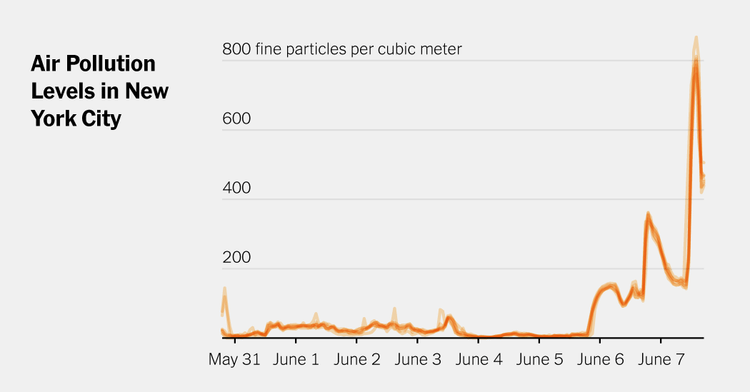Just How Bad Was the Pollution in New York?

Fine Particle Pollution at Seven Locations in New York City 200 400 600 800 micrograms per cubic meterMay 31June 1June 2June 3June 4June 5June 6June 7June 8868: Wednesday’s peak value466: Record daily avg. in Portland, Ore. (2020 wildfires) 178: Record daily avg. in San Francisco (2018 wildfires) 86: Previous N.Y.C. daily record avg. (2003) 35: E.P.A.’s safe daily levels 377: Daily average in N.Y.C. on Wednesday
Source: New York City Community Air Survey and New York State Department of Environmental Conservation Curves show hourly concentrations of PM2.5 particles, measured in micrograms per cubic meter, for seven N.Y.C. locations, as of 7 a.m. on Thursday. Records reflect the Environmental Protection Agency’s highest daily average PM2.5 concentration for a given city from 1999 to 2023.
The air in New York City on Wednesday wasn’t just bad by the city’s standards. It was historically bad, even compared with places around the world that generally experience much more air pollution.
The chart above shows the concentration of a particularly dangerous kind of air pollution, as measured by the state’s Department of Environmental Conservation from a network of sensors around the city.
Those sensors measured levels of particles 2.5 microns in diameter or smaller, brought by wind from wildfires in Canada. Wednesday’s daily average was the highest since recording in New York began in 1999. (The second-highest level was on Tuesday.) Wednesday’s level of pollution was also higher than the worst daily average record in San Francisco — on Nov. 16, 2018, when wildfires were blazing in Northern California — and it approached average pollution levels recorded in Portland, Ore., on Sept. 13, 2020, during the worst of its pollution from nearby wildfires.
The small particles measured by the sensors — each about a 30th as wide as a human hair — are dangerous to human health because they are tiny enough to penetrate into the lungs and bloodstream. The Environmental Protection Agency closely tracks pollution of this type from smokestacks and vehicles.
Thirty-five micrograms of the particles per cubic meter of air is considered a safe average level in the air for one day, according to the agency. Wednesday’s average level in seven stations across the city was 377, nearly 11 times as much as that threshold.
Wednesday’s pollution, of course, was not caused by a power plant or vehicles, but by major wildfires in Canada, mostly in Quebec. Fires of this magnitude are unusual in the eastern part of North America, said Eric James, a research associate at the University of Colorado, who works on the model used by the National Oceanic and Atmospheric Administration to predict the movement of smoke from wildfires. The East Coast tends to have more rain in the summer than the western half of the continent, where wildfires are so common that they have a season. An unusual weather pattern pushing the pollution down the coast is also a culprit, he said.
Source: National Oceanic and Atmospheric Administration
How long the air will stay dangerous depends on what happens with the fires, the weather in Canada and the wind. Weather forecasters trying to predict the air quality struggle to make estimates with much precision beyond a 48-hour window, Mr. James said. Their models rely on satellite measurements of the magnitude of wildfires, but do not predict whether the fires will get better or worse over time, beyond a typical pattern of growing slightly stronger during the hot part of the day and slightly weaker at night.
Predicting the wind that moves the smoke around is also a challenge, particularly during the summer. Wind during the winter tends to be more predictable. Summer winds are often produced by thunderstorms, which are small, local and typically short-lived. The New York area could see improvement Thursday and Friday with smoke expected to move southward and west, the National Weather Service said, but any major change may not occur until early next week.



























































